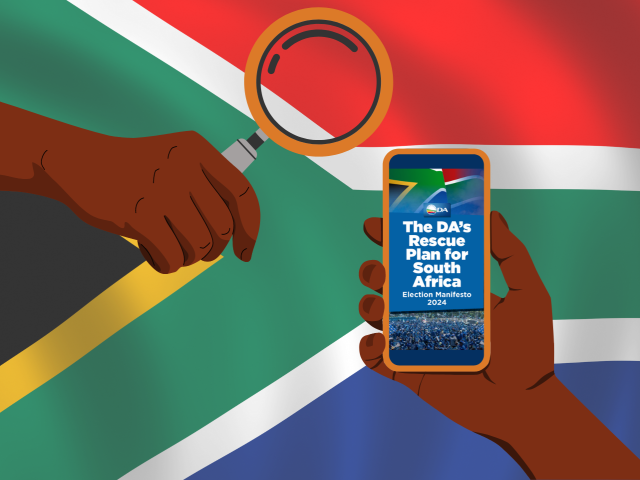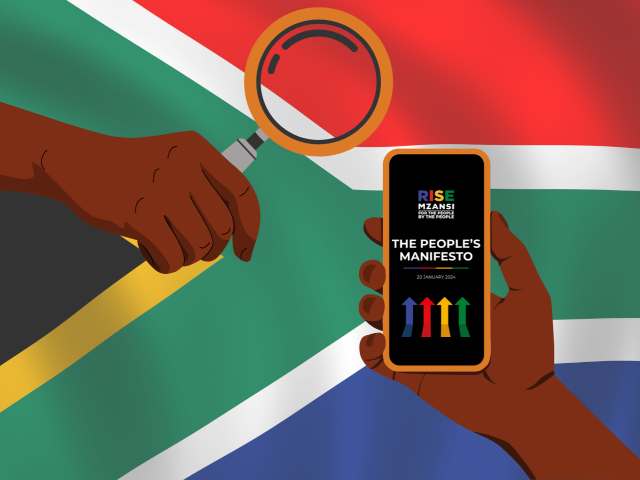- The International Monetary Fund’s US$2.34 billion loan to Kenya’s government, announced in April 2021, has led to online protests using hashtags such as #stoploaningkenya and #StopGivingKenyaLoans.
- In a TV interview with the South African Broadcasting Corporation, Kenyan economist David Owiro said his country’s current debt stock was 100% of gross domestic product, or GDP.
- Owiro told Africa Check he had “misspoken”. The official debt to GDP ratio is 65.6%, but by current projections it could rise to 100% by 2030.
In April 2021 the International Monetary Fund found itself in an online storm as thousands of Kenyans protested a US$2.34 billion loan it had advanced to their government.
Kenya’s treasury said the money would help with its response to the Covid-19 pandemic, strengthen economic reforms and reduce its future debt burden.
But some were cynical, with one petition attracting more than 230,000 signatures by 9 April while hashtags such as #stoploaningkenya and #StopGivingKenyaLoans influenced online conversations.
Protesters said previous debt had not been used prudently. In response, the IMF said that without its support, Kenya would face higher taxes and have to borrow on more expensive terms.
As the public debate raged, the South African Broadcasting Corporation interviewed Kenyan economist David Owiro on TV.
Kenya was not yet in distress, Owiro said, “but the stock of debt is currently standing at about 100% of GDP”. A country’s gross domestic product is a measure of the size of its economy.
Interviewer Peter Ndoro was aghast. “Hundred percent? Wow, but that would suggest almost insolvency.”
Owiro said the IMF was satisfied with Kenya’s ability to repay. But is the eye-widening figure he gave accurate?
‘This is not true’
Owiro told Africa Check that he had “misspoken” and the figure was much lower. He said he had asked the show’s producer to clarify the error. Owiro is the founder of the Nairobi-based Africa Development Think Tank, which does research for governments and organisations to help them make decisions based on evidence.
So what is the correct figure?
Dr Abraham Rugo is the Kenya country manager for the International Budget Partnership, a public finance and budget think tank. He told Africa Check the claim was incorrect. “This is not true,” he said.
For the accurate figure, Rugo referred Africa Check to the 2021 debt management strategy published by Kenya’s national treasury in February 2021.
The strategy puts the country’s public and publicly guaranteed debt at KSh7.3 trillion ($66.7 billion) as of December 2021. This accounts for 65.6% of gross domestic product.
‘Debt to GDP ratio doesn’t tell you much’
Kwame Owino, the chief executive of think tank Institute of Economic Affairs-Kenya, also said that the claim was incorrect. “Based on what’s been declared, it’s not 100%.”
Owino directed Africa Check to the IMF report that accompanied disclosure of the loan. This estimates that Kenya’s public debt was 65.8% of GDP in 2020. The report also forecast that this would increase to 70.4% this year, 72.6% in 2022 and 72.9% in 2023.
But the size of the debt relative to GDP alone “doesn’t tell you much”, Owino said.
“What matters is the payment terms. So if the size of the debt to GDP ratio is 100% but it is a 200-year loan, it will not be stressful. Japan and the US have low servicing costs because their loans are long-tenure.”
Debt burden may hinder economic growth
Owino gave more context. “We need to ask ourselves what the debt-servicing cost relative to revenues is, because debt is paid from revenues.
“That is where countries get overwhelmed and that is where Kenya’s problem is. Paying loans and serving recurrent expenditure is not possible from revenues, and so you run into the problem where you need to borrow from one person to pay another.”
James Muraguri is the chief executive officer of the Institute of Public Finance Kenya think tank. He told Africa Check that Kenya’s appetite for borrowing was linked to its sizable fiscal deficits – the gap between the government’s revenue and its spending. The deficit increased from 7.3% of GDP in the 2017/18 financial year to 8.2% in 2019/20. The target was 3%.
“In the absence of fiscal discipline, it will be difficult for the government to sustain economic growth,” Muraguri said. “The economy will be susceptible to macroeconomic shocks and instabilities in the global economy.”
Debt may reach 100% of GDP by 2030
Spending on infrastructure and debt servicing would increase Kenya’s debt, the Parliamentary Budget Office said in a January 2021 report.
The budget office supports parliament’s oversight function through research.
It cautioned that the country’s debt stock was “projected to double by June 2030 and could account for over 100% of GDP”.
Debt relief gives Kenya breathing space
According to a debt management strategy published by Kenya’s national treasury in February 2021, the country will spend KSh458.2 billion servicing debt for the current 2020/21 financial year, against expected revenue of KSh815.9 billion.
For 2021/22 this would rise to KSh560.6 billion of a projected KSh1.2 trillion in revenue. One reason for the lower payments in the current financial year is a debt service suspension plan that Kenya is part of, Kwame Owino, the chief executive of think tank Institute of Economic Affairs-Kenya, said.
This is a temporary suspension of repayments that wealthier countries agreed on, to ease debt pressure as debtor countries try to recover from the Covid-19 pandemic. “You’re just getting a breather,” Owino said.
Under the plan Kenya is expected to get temporary relief of $630.8 million from May to December 2020, and $620.3 million from January to June 2021.
In April 2021 Kenya’s treasury said it was pushing to have this relief extended to June 2022.
Conclusion: Official data puts Kenya’s current debt at 65.6% of GDP
In an April 2021 TV interview with the South African Broadcasting Corporation, Kenyan economist David Owiro put Kenya’s debt stock “at about 100% of its gross domestic product” (GDP).
Owiro told Africa Check he had misspoken and that the actual figure was much lower. The most recent official data shows the country’s debt to GDP ratio is at about 65.6%.
But a key office that advises parliament warns that if public debt is not well managed and the economy underperforms the ratio could rise to 100% – in 2030.








Add new comment